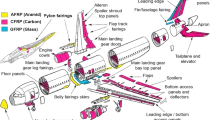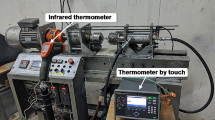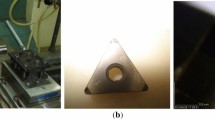Abstract
Threading is a process that generates internal and external threads, and it is widely used in various applications in industries as threads can be found in almost all industrial mechanical component assemblies due to precision and speed. In machining, threading is one of the most critical processes. The machining process focused on this study is responsible for the thread to fix the engine gear on the crankshaft. The modernization of internal combustion engines has required evolution concerning dimensional accuracy unprecedented in the mechanical industry and better mechanical and tribological properties at a low cost. One solution that has been researched in depth to overcome the threading machining problems is to use coated tools. Therefore, this study aims to analyze the performance of different thread tapping tools regarding cutting tool life cycle and wear mechanisms during the internal threading of a nodular iron engine crankshaft. The tools used were sintered uncoated High-Speed Steel – HSS-PM, coated HSS-PM (TiN), and HSS-PM (TiCN). The wear measurement on each cutting core was evaluated using a laser beam and calculated by a measuring equipment software. It was observed/shown that the wear mechanism for the HSS-PM tool is the plastic deformation with the formation of cracks in regions of the Co/Cr/C binder. Moreover, the tools coated with TiN and TiCN showed abrasive wear of the coating and localized peeling, especially at some zone where it had low substrate adhesion, tool wear. The sharp softening of the HSS-PM tool after fracturing in 2100 threads may be caused by the low temperature reached in the cut or the presence of W, V, and C in the microstructure. HSS-PM (TiCN) taps performed better than HSS-PM (TiN) (21% better), as well as uncoated HSS-PM (86% better).










Similar content being viewed by others

Availability of data and materials
The datasets obtained during the current work are available from the corresponding author upon request.
Abbreviations
- BUE:
-
Built-Up Edge
- COF:
-
Coefficient Of Friction
- TiCN:
-
Titanium Carbon Nitride
- TiAlN:
-
Titanium Aluminum Nitride
- AlCr:
-
Aluminum Chromium
- AlTiN:
-
Aluminum Titanium Nitride
- TiN:
-
Titanium Nitride
- PVD:
-
Physical Vapor Deposition
- CVD:
-
Chemical Vapor Deposition
- HSS-PM:
-
High-Speed Steel Powder Metallurgy
- DLC:
-
Diamond-Like Carbon
- C:
-
Carbon
- Si:
-
Silicon
- Mn:
-
Manganese
- P:
-
Phosphorus
- S:
-
Sulfur
- Mg:
-
Magnesium
- Cu:
-
Copper
- HV:
-
Hardness Vickers
- ISO:
-
International Standard Organization
- SEM:
-
Scanning Electronic Microscope
- FEG:
-
Field Emission Gun
- H:
-
Hardness
- E:
-
Young's modulus
- CNC:
-
Computer Numerical Control
- \({A}_{P}\) :
-
Area of the clearance face for each fillet
- \({A}_{SP}\) :
-
Worn area of the clearance face for the
- W:
-
Tungsten
- Cr:
-
Chromium
- V:
-
Vanadium
- Mo:
-
Molybdenum
- EDS:
-
Energy Dispersive X-ray Spectroscopy
- Ti:
-
Titanium
- Fe:
-
Iron
References
de Oliveira JA, Ribeiro Filho SLM, Brandão LC (2019) Investigation of the influence of coating and the tapered entry in the internal forming tapping process. Int J Adv Manuf Technol 101:1051–1063. https://doi.org/10.1007/s00170-018-3011-9
Fernandes GHN, Lopes GHF, Barbosa LMQ, Martins PS, Machado ÁR (2021) Wear mechanisms of diamond-like carbon coated tools in tapping of AA6351 T6 aluminium alloy. Procedia Manuf 53:293–298. https://doi.org/10.1016/j.promfg.2021.06.032
Leach F, Kalghatgi G, Stone R, Miles P (2020) The scope for improving the efficiency and environmental impact of internal combustion engines. Transp Eng 1:100005. https://doi.org/10.1016/j.treng.2020.100005
Conway G, Joshi A, Leach F, García A, Senecal PK (2021) A review of current and future powertrain technologies and trends in 2020. Transp Eng 5:100080. https://doi.org/10.1016/j.treng.2021.100080
Pascoal ET, Delamaro MC, Ibusuki U, Tsukada O, Rocha HM (2017) The new Brazilian automotive policy and its impact on the competitiveness of multinational automobile and auto parts manufacturers. Int J Automot Technol Manag 17:225. https://doi.org/10.1504/IJATM.2017.086405
Yang YM (2018) A study on characteristics of dimensional accuracy using planning number of machining in machining center. Korean Soc Manuf Process Eng 17:61–67. https://doi.org/10.14775/ksmpe.2018.17.6.061
Taub A, De Moor E, Luo A, Matlock DK, Speer JG, Vaidya U (2019) Materials for automotive lightweighting. Annu Rev Mater Res 49:327–359. https://doi.org/10.1146/annurev-matsci-070218-010134
Madhan Kumar S, Govindaraj E, Balamurugan D, Daniel F (2021) Design analysis and fabrication of automotive transmission gearbox using hollow gears for weight reduction. Mater Today Proc 45:6822–6832. https://doi.org/10.1016/j.matpr.2020.12.1005
Dekker L, Tonn B (2016) Occurrence and behaviour of Mo containing precipitates in nodular cast iron at high temperatures. Int J Cast Met Res 29:85–91. https://doi.org/10.1179/1743133615Y.0000000024
Vinayagamoorthy R (2018) A review on the machining of fiber-reinforced polymeric laminates. J Reinf Plast Compos 37:49–59. https://doi.org/10.1177/0731684417731530
Aslantas K, Ucun I (2009) The performance of ceramic and cermet cutting tools for the machining of austempered ductile iron. Int J Adv Manuf Technol 41:642–650. https://doi.org/10.1007/s00170-008-1528-z
Wang B, Barber GC, Tao C, Sun X, Ran X (2018) Characteristics of tempering response of austempered ductile iron. J Mater Res Technol 7:198–202. https://doi.org/10.1016/j.jmrt.2017.08.011
Meier L, Hofmann M, Saal P, Volk W, Hoffmann H (2013) In-situ measurement of phase transformation kinetics in austempered ductile iron. Mater Charact 85:124–133. https://doi.org/10.1016/j.matchar.2013.09.005
Ba ECT, Dumont MR, Martins PS, Drumond RM, Martins da Cruz MP, Vieira VF (2021) Investigation of the effects of skewness Rsk and kurtosis Rku on tribological behavior in a pin-on-disc test of surfaces machined by conventional milling and turning processes. Mater Res 24:1–14. https://doi.org/10.1590/1980-5373-mr-2020-0435
Martins PS, Carneiro JRG, Ba ECT, Vieira VF, Amaral DB, da Cruz NC (2022) Study on the Tribological behavior of wear and friction coefficient on AISI M35 high-speed steel with and without DLC coating. Mater Res 25:e20200577. https://doi.org/10.1590/1980-5373-mr-2020-0577
Liu Y, Zhao J (2018) Study on Vibration Tapping for SiCp/Al Particle-reinforced Metal Matrix Composite. MATEC Web Conf 228:04005. https://doi.org/10.1051/matecconf/201822804005
Gil-Del-Val A, Diéguez PM, Arizmendi M, Estrems M (2015) Experimental study of tapping wear mechanisms on nodular cast iron. Procedia Eng 132:190–196. https://doi.org/10.1016/j.proeng.2015.12.469
Gil Del Val A, Veiga F, Suárez A, Arizmendi M (2020) Thread quality control in high-speed tapping cycles. J Manuf Mater Process 4:9. https://doi.org/10.3390/jmmp4010009
Martins PS, GonçalvesCarneiro JR, Ba ECT, Vieira VF (2021) Study on roughness and form errors linked with tool wear in the drilling process of an Al-Si alloy under high cutting speed using coated diamond-like carbon high-speed steel drill bits. J Manuf Process 62:711–719. https://doi.org/10.1016/j.jmapro.2021.01.006
Klocke F, Krieg T (1999) Coated tools for metal cutting – features and applications. CIRP Ann 48:515–525. https://doi.org/10.1016/S0007-8506(07)63231-4
Bobzin K (2017) High-performance coatings for cutting tools. CIRP J Manuf Sci Technol 18:1–9. https://doi.org/10.1016/j.cirpj.2016.11.004
Sousa VFC, Silva FJG (2020) Recent advances on coated milling tool technology—a comprehensive review. Coatings 10:235. https://doi.org/10.3390/coatings10030235
Gupta KM, Ramdev K, Dharmateja S, Sivarajan S (2018) Cutting characteristics of PVD coated cutting tools. Mater Today Proc 5:11260–11267. https://doi.org/10.1016/j.matpr.2018.02.092
Elosegui I, Alonso U, Lopez de Lacalle LN (2017) PVD coatings for thread tapping of austempered ductile iron. Int J Adv Manuf Technol 91:2663–2672. https://doi.org/10.1007/s00170-016-9963-8
Othman MF, Bushroa AR, Abdullah WNR (2015) Evaluation techniques and improvements of adhesion strength for TiN coating in tool applications: a review. J Adhes Sci Technol 29:569–591. https://doi.org/10.1080/01694243.2014.997379
Uddin GM, Joyia FM, Ghufran M, Khan SA, Raza MA, Faisal M, Arafat SM, Zubair SWH, Jawad M, Zafar MQ, Irfan M, Waseem B, Chaudhry IA, Zeid I (2021) Comparative performance analysis of cemented carbide, TiN, TiAlN, and PCD coated inserts in dry machining of Al 2024 alloy. Int J Adv Manuf Technol 112:1461–1481. https://doi.org/10.1007/s00170-020-06315-5
Chuan SP, Ghani JA, Tomadi SH, Hassan CHC (2012) Analysis of Ti-base hard coating performance in machining process: A review. J Appl Sci 12:1882–1890. https://doi.org/10.3923/jas.2012.1882.1890
Jindal PC, Santhanam AT, Schleinkofer U, Shuster AF (1999) Performance of PVD TiN, TiCN, and TiAlN coated cemented carbide tools in turning. Int J Refract Met Hard Mater 17:163–170. https://doi.org/10.1016/S0263-4368(99)00008-6
Zhao J, Liu Z, Wang B, Hu J, Wan Y (2021) Tool coating effects on cutting temperature during metal cutting processes: comprehensive review and future research directions. Mech Syst Signal Process 150:107302. https://doi.org/10.1016/j.ymssp.2020.107302
Martins PS, Almeida MagalhãesJúnior PA, GonçalvesCarneiro JR, Talibouya Ba EC, Vieira VF (2022) Study of Diamond-Like Carbon coating application on carbide substrate for cutting tools used in the drilling process of an Al–Si alloy at high cutting speeds. Wear. https://doi.org/10.1016/j.wear.2022.204326
Barooah RK, Paiva JM, Arif AFM, Rawal S, Bose B, Veldhuis SC (2021) Investigation on wear mechanisms of PVD coatings for form taps in threading of Al–Si alloy. Wear 464–465:203528. https://doi.org/10.1016/j.wear.2020.203528
Gil Del Val A, Veiga F, Pereira O, Lopez De Lacalle LN (2020) Threading performance of different coatings for high speed steel tapping. Coatings 10:464. https://doi.org/10.3390/coatings10050464
de Freitas SA, Vieira JT, Filho SLMR, Brandão LC (2019) Experimental investigation of tapping in CFRP with analysis of torque-tension resistance. Int J Adv Manuf Technol 104:757–766. https://doi.org/10.1007/s00170-019-03955-0
Bhargava AK, Banerjee MK (2017) 2.2 Hardenability of steel. Compr Mater Finish 50–70. https://doi.org/10.1016/B978-0-12-803581-8.09186-4
Podgornik B, Sedlaček M, Žužek B, Guštin A (2020) Properties of tool steels and their importance when used in a coated system. Coatings 10:265. https://doi.org/10.3390/coatings10030265
Diez-Pastor JF, Gil Del Val A, Veiga F, Bustillo A (2021) High-accuracy classification of thread quality in tapping processes with ensembles of classifiers for imbalanced learning. Meas J Int Meas Confed 168:108328. https://doi.org/10.1016/j.measurement.2020.108328
Gil Del Val A, Fernández J, Del Castillo E, Arizmendi M, Veiga F (2013) Monitoring of thread quality when tapping nodular cast iron with TiN-coated HSS cutting taps. Int J Adv Manuf Technol 69:1273–1282. https://doi.org/10.1007/s00170-013-5078-7
Ramos-Moore E, Espinoza C, Coelho RS, Pinto H, Brito P, Soldera F, Mücklich F, Garcia JL (2014) Investigations on thermal stresses of a graded Ti(C, N) coating deposited on WC-Co hardmetal. Adv Mater Res 996:848–854. https://doi.org/10.4028/www.scientific.net/AMR.996.848
Mills B (1996) Recent developments in cutting tool materials. J Mater Process Technol 56:16–23. https://doi.org/10.1016/0924-0136(95)01816-6
Qi W, Fu S, Li T, Ye F, Guan S, Chen S (2021) Investigation of preparation and properties of TiCN coatings by reactive plasma spraying. J Phys Conf Ser 1983:012103. https://doi.org/10.1088/1742-6596/1983/1/012103
Acknowledgements
The authors would like to thank the Pontifícia Universidade Católica de Minas Gerais; STELLANTIS LATAM (Betim, Minas Gerais, Brazil) for the availability of materials and analysis laboratories; and colleagues Breno Siqueira from Emuge and Wandeir Braga from Guhring for preparing and supplying all the tools that were needed.
Funding
This study was funded by CAPES, Coordination for the Improvement of Higher Education Personnel, Finance Code 001, which supported this work [Brasília, Brazil, CEP: 70.040–031, CNPJ: 00889834/0001–08].
Author information
Authors and Affiliations
Corresponding author
Ethics declarations
Ethics approval
This article requires informed consent of the authors; it does not have any disclosure of potential conflicts of interest and does not involve human and/or animal participants.
Consent to participate
The authors declare that they consent to participate in this paper.
Consent to publish
The authors declare that they consent to publish this paper.
Competing interests
The authors declare no competing interests.
Additional information
Publisher's note
Springer Nature remains neutral with regard to jurisdictional claims in published maps and institutional affiliations.
Rights and permissions
About this article
Cite this article
Martins, P.S., dos Santos, J.O., Carneiro, J.R.G. et al. Study of wear behavior and tool life in different taps during the internal threading of a nodular iron engine crankshaft. Int J Adv Manuf Technol 120, 7803–7814 (2022). https://doi.org/10.1007/s00170-022-09290-1
Received:
Accepted:
Published:
Issue Date:
DOI: https://doi.org/10.1007/s00170-022-09290-1



